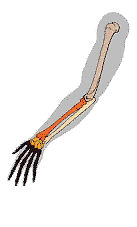Quote:
"I presume the air sacs are also involved in fire brathing?" Jaren asked. "Or would it be the lungs?"
"Actually the air sacs have very little to do with fire breathing, if you look closely at the figure, you will see that #3, the Jacobson's organ is the primary organ involved with fire breathing....but I will get into that later. I would first like to concentrate on flight. The wings of a dragon are based on the principle arm of any animal, i.e. they consist of an thumb and four very lengthened fingers, the whole connected with a membrane as we can observe in the bat. It is significant to understand that the similar struture between the shoulder, the arm and the hand is homologous with the corresponding structures of the wing for the dragon."
HM Hendrik points his wand at the board...(ooc:give the image a moment to load...it changes for you)
 "It is also important to understand that the membrane of the wing does not attaches close to the shoulder as certain biologically erroneous drawings can sometimes show but near the bottom of the back of the dragon close to the thighs. This is very important since if the wings would be connected in the top of the back, the dragon would fly but it would have a vertical position (head up, posterior & tail down) that would be a serious disadvantage for the speed and also for the maneuvrability. When the wings are connected at the bottom of the back, the dragon can have a horizontal position and thus the head and the tail can be used as rudder and allows a great maneuvrability (at least, definitely higher than the vertical position). This also allows a greater surface for the wings (a critical element in flight)."
"It is also important to understand that the membrane of the wing does not attaches close to the shoulder as certain biologically erroneous drawings can sometimes show but near the bottom of the back of the dragon close to the thighs. This is very important since if the wings would be connected in the top of the back, the dragon would fly but it would have a vertical position (head up, posterior & tail down) that would be a serious disadvantage for the speed and also for the maneuvrability. When the wings are connected at the bottom of the back, the dragon can have a horizontal position and thus the head and the tail can be used as rudder and allows a great maneuvrability (at least, definitely higher than the vertical position). This also allows a greater surface for the wings (a critical element in flight)."